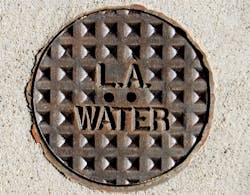The U.S. Environmental Protection Agency (EPA) and the Los Angeles Regional Water Quality Control Board announced the latest in a series of pollution reduction plans designed to restore 175 water bodies in Los Angeles and Ventura Counties. The pollution targets set by these plans will improve water quality, restore ecosystems and protect the public by eliminating beach closures due to bacteria and improving the health of fish used for consumption.
“EPA and our partners have achieved a breakthrough on the path toward restoring the health of Los Angeles’ creeks, streams and beaches,” said Jared Blumenfeld, EPA’s Regional Administrator for the Pacific Southwest. “These precious natural resources lay at the heart of what makes the Golden State shine.”
The Los Angeles region is home to a vast network of streams, lakes, rivers and beaches used for fishing and recreation. The pollution plans call for reductions in the amount of bacteria, nitrogen, phosphorus, mercury, pesticides and other toxic chemicals that affect these waterways. More than 95% of the impaired waters will meet applicable water quality standards once the pollution reduction plans are fully implemented.
“I am proud to acknowledge achievements that are leading to healthier watersheds for the benefit of the people and wildlife who call the Los Angeles area home,” said Maria Mehranian, chair of the Los Angeles Regional Water Quality Control Board. “This wave of water quality improvement is the result of tremendous efforts by this board, past boards and the EPA in collaboration with local municipalities and environmental organizations.”
Under the federal Clean Water Act, states are required to develop pollution reduction plans for waters that are impaired by pollutants. These plans are called Total Maximum Daily Loads (TMDLs) and must be approved by the EPA.
“Los Angeles’ relationship to water is a historic one. We are known for our beaches and were founded because of the LA River,” said Mayor Antonio Villaraigosa. “The U.S. EPA and the Regional Water Board have been strong partners as we work to protect our rivers, streams and waterways. We applaud the U.S. EPA and the Regional Water Board for continuing to prioritize water quality and safety in Los Angeles.”
Today’s announcement is a part of a 1999 legal settlement between EPA and local environmental groups in which the EPA committed to approve LA Water Board-developed TMDLs or independently establish TMDLs for a list of water bodies in the Los Angeles Region. As a result of the consent decree, 47 TMDLs have been established for 175 water bodies that address numerous pollutant impairments including elevated bacteria, metals, pesticides, PCBs and trash. Additional TMDLs will be approved or established within the next year.
“The consent decree put Los Angeles and Ventura counties on track for having oceans and rivers that are safe for swimming and fishing year round,” said Kirsten James, Heal the Bay’s water quality director. “The implementation of these requirements has already led to less trash in local rivers and bays and cleaner beaches.”
EPA established four TMDLs to address pollutants and impairments for the following water bodies:
- 1. Long Beach City beaches and Los Angeles River estuary for bacteria: will help protect the health of the tens of thousands of people visiting the beaches during summer months. Once implemented, the average number of days during the swimming season exceeding bacteria standards will be reduced from 34 days to 0.
- 2. Santa Monica Bay waters for DDTs and PCBs: will increase the health of the fish and other aquatic life and protect the public who use the Bay for recreational fishing and boating. Once implemented, DDT and PCB levels in the Bay will be reduced up to 50% and 75%, respectively.
- 3. Ballona Creek wetlands for sediment and exotic vegetation: will help restore the last remaining critical coastal wetlands in southern California. Once implemented, 600 acres of habitats adjacent to Marina del Rey will support the hundreds of migratory birds species and the dozens of native birds that use these wetlands.
- 4. Nine Los Angeles area urban lakes for toxins, trash, nitrogen and phosphorus pollution: will support recreation and wildlife for nine lakes in the Los Angeles area, including Echo Park Lake, Lake Calabasas, Puddingstone Reservoir and El Dorado Park Lakes.
In addition, the EPA has approved four LA Water Board-adopted TMDLs to address pollutants and impairments for the following water bodies:
- 1. Los Angeles and Long Beach Harbors for toxic pollutants: will reduce toxic levels of metals and organic pollutants to protect sensitive habitat, fishing, recreation and navigation in the harbors.
- 2. Machado Lake for toxic pollutants: will remediate contaminated water and sediments in the lake so that fish are safe to eat.
- 3. Los Angeles River for bacteria: will protect the health of swimmers, waders and boaters in the river and at downstream beaches in the City of Long Beach.
- 4. Santa Monica Bay for trash: will prohibit trash and plastic pellets (“nurdles”) from entering the bay to protect beachgoers and marine life.
Pollution reduction plans adopted over the years have led to innovative solutions by municipalities and pollution equipment industries to address some of the most deep-rooted pollution problems in the region. These plans have led to the installation of trash capture devices by 42 cities resulting in a 65% reduction in total tons of trash entering the Los Angeles River. The landmark Santa Monica Bay beaches bacteria TMDL has, since its adoption, reduced exceedances of bacteria standards at local beaches by half for the benefit of the 55 million people who visit Santa Monica Bay beaches annually.
Source: U.S. EPA


